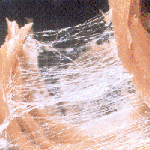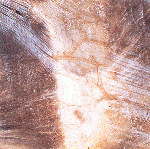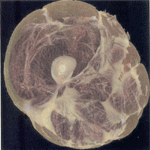The term fascia is a Latin word that means “band” or “bandage.” It is used when we are discussing fibrous connective structures that don’t have a more specific definition. You would be safe to think of fascia as any connective tissue that doesn’t have a more specific name. [1]
Fascia can vary in thickness and density depending upon where it is, and what it is being used for. Often it is found in sheets. There is a type of fascia located just beneath the surface of the skin (called the “superficial fascia” or “hypodermis”) and another type directly beneath this (called the “deep fascia”), which is usually tougher and tighter than the superficial fascia. Embedded inside this deep fascia are the tissues of the muscles, the blood vessels, and all the other tubes that wind through the body. A third kind of fascia lines the body’s cavities. For our purposes we are mostly interested in the deep fascia and how it contributes to the flexibility of the muscles.
As seen in these three images, muscle fibers are embedded inside the deep fascia. In the first image the fascia has been teased so that it is easy to see. [2] The second image again shows muscles and fascia, the fascia being the streaks of white. The third image shows the pervasiveness of the fascia. Normal anatomy drawings don’t show the fascia and concentrate only on the muscles, leading to a misguided impression that the muscles (and the bones, etc.) are distinct, separate systems within our body. Distinct they are – separate they are not.
In reality, as shown here, everything is interconnected, and all the tissues work together. The deep fascia merges with all the other tissues embedded within it. Even the organs cannot be completely separated from the bed of deep fascia. The organs are continuous with the fascia. The muscles are the same. We can make only an arbitrary definition as to what is muscle tissue and what is deep fascia. They are actually one continuum. What we do to one, we do to all. For this reason some modern texts and body workers prefer to use the term “myofascial” to refer to the muscle and fascia together. After all, it is impossible to contract or stretch our muscles without also compressing or stretching our fascia.
The fascia can make up thirty percent of the tissue in the muscle. There are probably three functions of the intramuscular fascia (or the connective tissue, as it is also called):
- It binds the muscle together, while ensuring proper alignment of the muscle fibers, the blood vessels flowing through the muscles, the nerves and other components of the muscle.
- It transmits the forces applied to the muscle evenly to all parts of the muscle.
- It lubricates the various surfaces that need to move or slide along each other.



The fascia is not only continuous with the muscles, organs, and all tissues found within it, the fascia is connected together throughout the body. In one model of our body, it is the fascia that holds us together. It is fascia that keeps the bones connected and upright – without fascia the bones would collapse to the floor, like a medical school skeleton without its wires.
This continuity within the fascia means a small movement in one area of the body pulls on the whole web of fascia connected throughout the body. If you are paying close attention, the slightest movement at one end of the body can be felt at the other end. This is what makes it possible to feel the movement of the breath everywhere in the body – all it requires is attention and practice.
As briefly mentioned above, fascia is sometimes called connective tissue. In fact, fascia can be considered to be a particular type of connective tissue but CT is even more pervasive than fascia and has a big impact as well on our flexibility and health. To really understand why yoga is so beneficial for us, we need to also understand our connective tissues.
These are important functions. It is the fascia that allows the muscle to change shape and lengthen. When we work to increase the range of motion of a muscle, it is not only the muscle fibers (the sarcomeres) that need to be freed up or lengthened; the fascia provides a great deal of the tensile resistance found in a muscle and needs to be released as well.
(Next: Connective Tissues )
